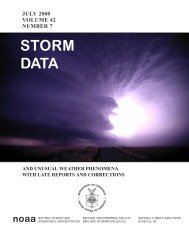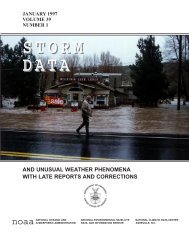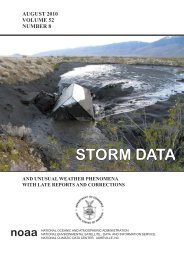Storm Data and Unusual Weather Phenomena - CIG
Storm Data and Unusual Weather Phenomena - CIG
Storm Data and Unusual Weather Phenomena - CIG
- No tags were found...
Create successful ePaper yourself
Turn your PDF publications into a flip-book with our unique Google optimized e-Paper software.
HAWAIIDuring the second half of the month, the ridge at all levels of the atmosphere shifted north. This resulted in the surface highnortheast of the isl<strong>and</strong>s strengthening <strong>and</strong> moving to a more average early spring position. The shift in weather patterns broughtstronger trade winds, which then produced more trade wind showers for the windward sides of the isl<strong>and</strong>s. This added rainfall hashelped relieve some of the very dry conditions in windward areas. However, much more rain is needed to get beyond the longerterm drought situation.Oahu:Below average precipitation again occurred in March as frontal systems that usually pass through or near the isl<strong>and</strong>s did notmaterialize. The greatest negative anomaly was in the leeward parts of the isl<strong>and</strong>, especially the central <strong>and</strong> southwest sections.The southwest side of Oahu, in the Waianae area (which is leeward of the Waianae Mountain range), saw the driest conditions.Only 2 to 20 percent of average precipitation (0.04 to 0.61 inches) occurred. Even what are usually the wettest sections of theisl<strong>and</strong>, the northeast facing windward areas <strong>and</strong> higher elevations of the Koolau Mountain range, received only 25 to 45 percent ofaverage rainfall.Maui County:Molokai <strong>and</strong> Lanai were below average at reporting stations, with Lanai City receiving 1.64 inches (44 percent of average rainfall).Isl<strong>and</strong> of Maui reporting stations showed below average precipitation at all locations as well. Negative anomalies were especiallynoted in areas with a dependence on synoptic scale precipitation in March, such as Lahainaluna, Kihei, <strong>and</strong> Ulupalakua. Thiscontinues the several month period of very dry conditions in those locales. Zero to 18 percent of average rainfall occurred in thoseareas, with no rain at Kihei <strong>and</strong> 0.42 of an inch at Lahainaluna. The rainfall total for Kihei over the past 8 months has been 1.83inches, which is only 14 percent of the average of 13.5 inches.Hawaii County:A dry pattern continued on the Big Isl<strong>and</strong>, with all areas seeing well below average rainfall. However, this is one isl<strong>and</strong> where thereturn of trade winds <strong>and</strong> showers was significant in helping to relieve some of the driest conditions in the state.The isl<strong>and</strong> wide negative precipitation anomaly is likely due to the decreased frequency of frontal systems <strong>and</strong>, also, possibly due toweaker or drier than average trade winds in the first half of the month. The Kona side of the isl<strong>and</strong>, dependent on convectiveprecipitation <strong>and</strong>, this time of the year, on synoptic scale precipitation patterns, was well below average at all reporting locations.Honaunau, south of Captain Cook, <strong>and</strong> Kealakekua were stations with the greatest negative rainfall anomaly with only 8 <strong>and</strong> 18percent of average precipitation, 0.42 of an inch <strong>and</strong> 0.99 of an inch, respectively.Kauai:<strong>Storm</strong> <strong>Data</strong> <strong>and</strong> <strong>Unusual</strong> <strong>Weather</strong> <strong>Phenomena</strong>TimePath PathNumber ofEstimatedLocal/ Length WidthPersonsDamageLocation DateSt<strong>and</strong>ard (Miles) (Yards) Killed Injured Property Crops Character of <strong>Storm</strong>All reporting stations had below average rainfall for the month. The most negative anomalous precipitation amounts in Marchoccurred in the south <strong>and</strong> southwest portions of the isle, with only 22 to 38 percent of average rainfall there. The east side of theisl<strong>and</strong> from Kapahi to Lihue received the greatest amounts of precipitation, but the totals were only 45 to 73 percent of average.The following are rainfall statistics (in inches) for selected locations on Oahu, Maui, the Isl<strong>and</strong> of Hawaii, <strong>and</strong> Molokai for March1998. For comparison, the average for the month <strong>and</strong> percent of average, respectively, are listed for each site in the next twocolumns. The following two columns represent the rainfall totals <strong>and</strong> average rainfall totals for the three month periodJanuary-March. The last three columns show rainfall totals from March 1994, March 1987, <strong>and</strong> March 1983, which were other ElNino-influenced time periods.Mar. 98 Avg. %Avg. 3 Month Avg./3 months Mar94 Mar87 Mar83OahuHonolulu 0.03 2.2 1 1.01 8.0 3.77 0.31 0.53Waianae 0.04 2.5 2 0.87 8.6 4.23 0.15 1.66Hawaii Kai 0.87 3.9 22 2.48 11.7 4.80 0.40 N/AManoaLyon A 5.92 14.4 41 14.69 37.8 27.43 4.17 2.12Waialua 0.24 3.8 6 2.90 13.3 4.14 1.62 2.03Ahuimanu(windward) 2.30 10.6 22 10.43 31.9 N/A 4.80 N/AMauiKahului 0.18 2.7 7 1.03 9.7 4.23 0.57 1.12Hana 1.16 9.5 12 2.36 25.8 27.54 3.50 2.32March 199852 46
















